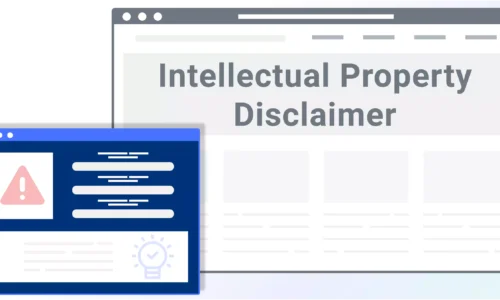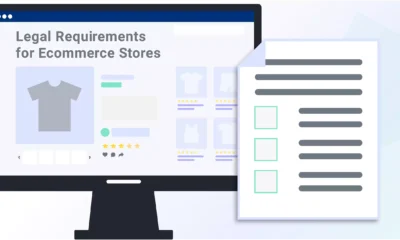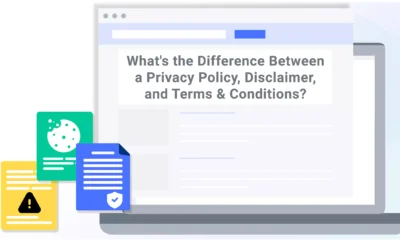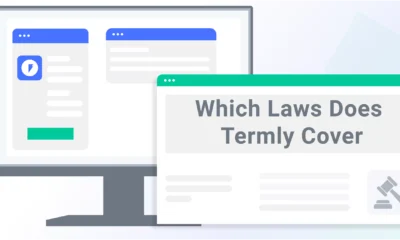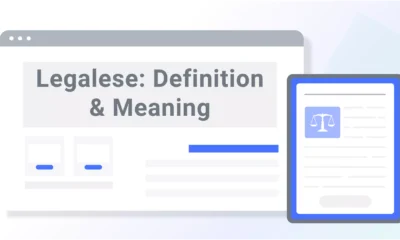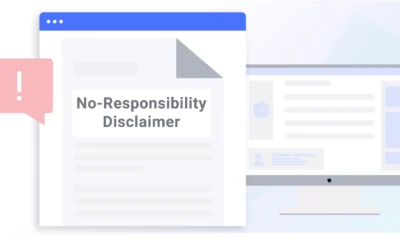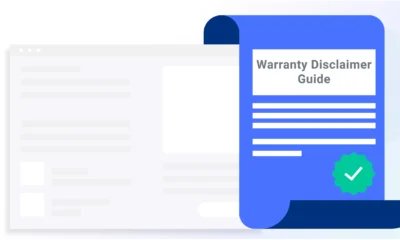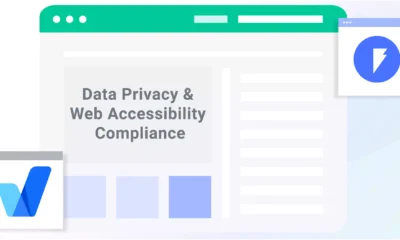Whether you have a website full of original content, use a custom logo, or post other creative materials, an intellectual property (IP) disclaimer can help protect you and your creations.
Intellectual property disclaimers inform people about the ownership rights you retain over the materials you post and explain how others can or can’t share or redistribute your work.
Below, I explain how and when to use an intellectual property disclaimer and provide you with some real-world examples.
How To Make an Intellectual Property Disclaimer
Make an intellectual property disclaimer for your website using a generator, template, or writing one yourself.
Generate a Free Customized Disclaimer Using Termly
Here’s how you can use Termly’s generator to create a custom and legally compliant disclaimer for your needs.
Step 1: Go to Termly’s disclaimer generator.
Step 2: Answer a few simple prompts and questions, and go through all of the steps until you reach “Final Details.”
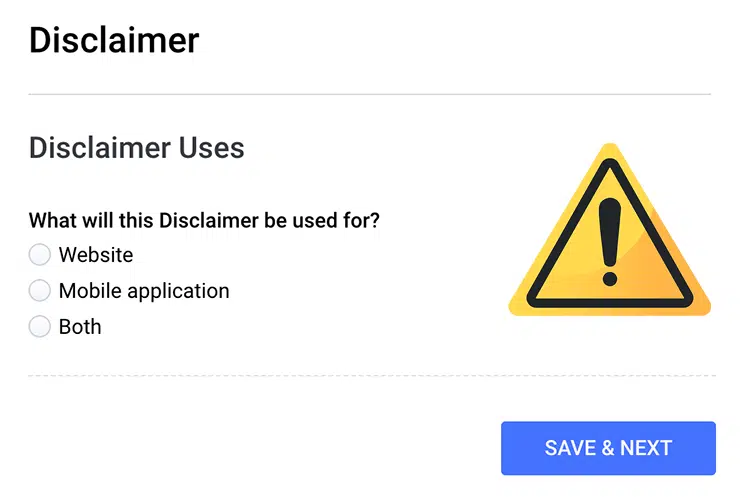
Step 3: Once you’ve filled in everything and are satisfied with the preview, click “Publish.” You will then be prompted to create an account on Termly to save and edit your legal disclaimer further.
Template
You can also download and customize our disclaimer template to make an intellectual property disclaimer for your website.
Simply fill in the blank sections with information about your business and list and name all materials and content to which the disclaimer applies.
You can then choose how you want to download and add or embed it to your website.
DIY
You can write your own intellectual property disclaimer — when doing so, focus on clarity.
While there are no strict legal requirements for the contents of your intellectual property disclaimer, there are elements that you should consider including.
Follow these steps to understand what essential information you might use while writing your intellectual property disclaimer.
These steps are a great place to start when drafting your intellectual property disclaimer and will help ensure you don’t accidentally leave out any vital information.
What Is an Intellectual Property Disclaimer Statement?
An intellectual property disclaimer is a statement that explains what rights of ownership you’re retaining over creative materials you make and describes if and how other people can share, use, or redistribute those materials.
Intellectual property includes anything developed by the human mind, including:
- Artwork
- Website designs
- Images
- Videos
- Choreography
- Written materials
- Branding
- Logos
Intellectual property, or IP, is often protected by trademarks, patents, or copyright laws:
- Trademarks: You can apply for a trademark to protect the ownership of your branding and logo, especially if it appears on your products.
- Patents: These apply to ideas and inventions; you must apply for one to protect your idea.
- Copyrights: Anything unique you create is automatically protected by copyright laws, regardless of whether you distribute it publicly.
A creator might be comfortable giving away their ownership rights to a creation or desire to protect it — this is where an intellectual property disclaimer statement comes in.
An intellectual property disclaimer clarifies the terms by which the creator will or will not release their work to another entity or person.
Intellectual Property Rights vs. Copyrights vs. Trademarks
Intellectual property is a broad term encompassing copyrighted materials, but not all examples of copyrights apply to every kind of intellectual property.
Technically, intellectual property includes everything from brand and industrial materials (e.g., logos, branding, website designs, etc.) to personal materials created by individuals (e.g., writings, drawings, art, etc.).
Conversely, copyright only refers to personal materials created by an individual, while trademark is the technical term for industrial-related content.
The three terms are closely related but technically refer to different ideas and materials.
Do I Need an Intellectual Property Disclaimer?
Even though intellectual property disclaimers aren’t required by law, it’s still a best practice to post one on your website because it helps protect and explain your ownership rights over the content you make.
If anyone uses your materials outside the scope you establish in your intellectual property disclaimer, you can point to it as evidence that the individual was made aware of your rights.
Proving that they had the opportunity to see and read the disclaimer may help you win your case in court.
Intellectual Property Disclaimer Examples
I recommend checking out examples of intellectual property disclaimers from around the web so you can get an idea of how other sites are protecting their works.
Website Intellectual Property Disclaimer
With so much original content online, placing an intellectual property disclaimer statement on a website has become one of the most common ways to use an IP disclaimer.
Below, I’ve provided an example of an intellectual property disclaimer from the makeup company Fenty Beauty — they include it on their Terms of Use page.
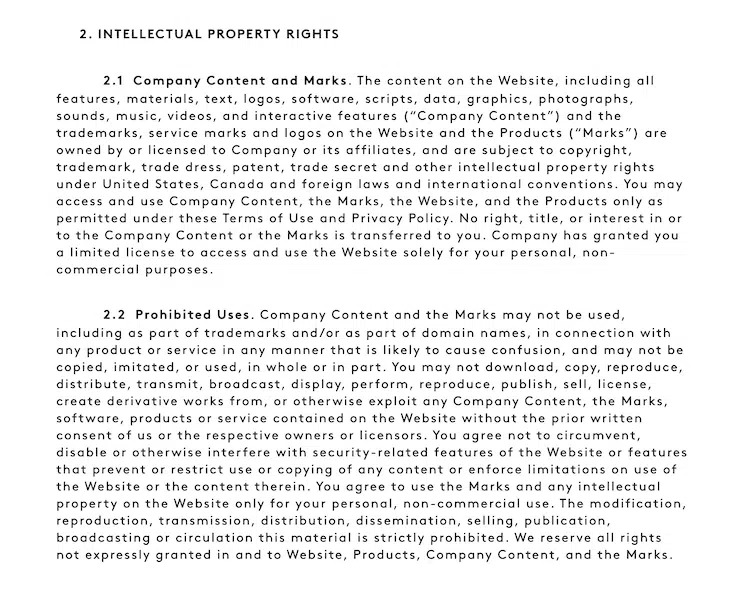
Fenty’s intellectual property disclaimer is a good sample to look at because of its clarity.
It states that all content on the site is “for your information and personal use only,” barring visitors from using, copying, reproducing, distributing, selling, licensing, or exploiting the property “for any other uses whatsoever.”
In your own disclaimer, try to mirror how Fenty’s statement effectively encompasses all of its content and clearly states the scope of its ownership.
Graphic Design Intellectual Property Disclaimer
For graphic design artists and brands, a graphic design intellectual property disclaimer is a must-have because it states your ownership over easily reproducible — and often misused — designs, like logos.
For example, the athletics fashion brand NIKE posts its intellectual property disclaimer on its Terms of Use page, which lays out its definition of content and how it can be used.
See more in the screenshot I provided for you below.
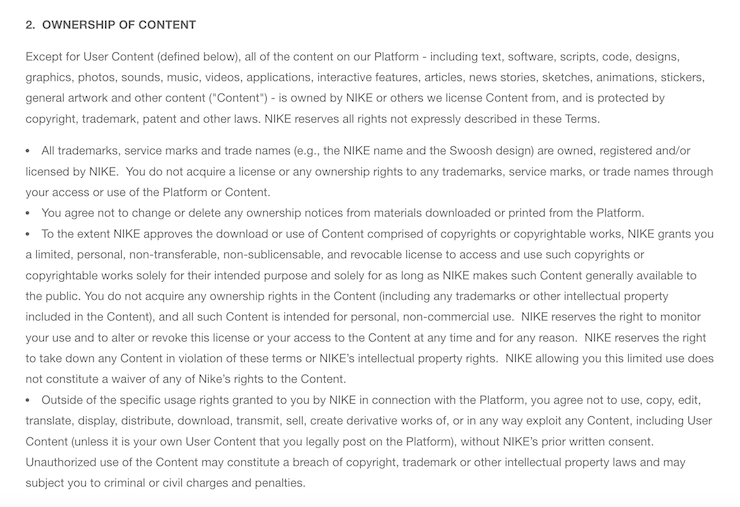
Notice that NIKE specifies within its statement that “the NIKE name and the Swoosh design,” in particular, are owned by the company.
Follow NIKE’s lead and make a note of and define your most prominent intellectual property to strengthen your protection of it.
Where Should I Put an Intellectual Property Disclaimer?
Where you put your disclaimer depends on what intellectual property and purpose you need it for, for example:
- Add one to the footer of your website to announce your ownership over the property.
- Include an IP disclaimer directly in any newsletters or branded email disclaimers.
- As a clause in your terms and conditions agreement.
- At the bottom of any materials or content on your site that users can download, including PDFs or other file formats.
- In the description of social media or YouTube posts featuring your intellectual property.
- Onto any web page as required, like at the bottom of an article or underneath your original video content.
Summary
If you post materials, branding, or content you make and own on your website, I suggest you protect it by making an intellectual property disclaimer.
Intellectual property disclaimers apply to your business’s branding and your personal copyrighted materials, making them essential disclosures that belong in your terms and conditions, your website footer, and any other applicable pages.
You can quickly make an intellectual property disclaimer for your website in minutes by using our Disclaimer Generator.

